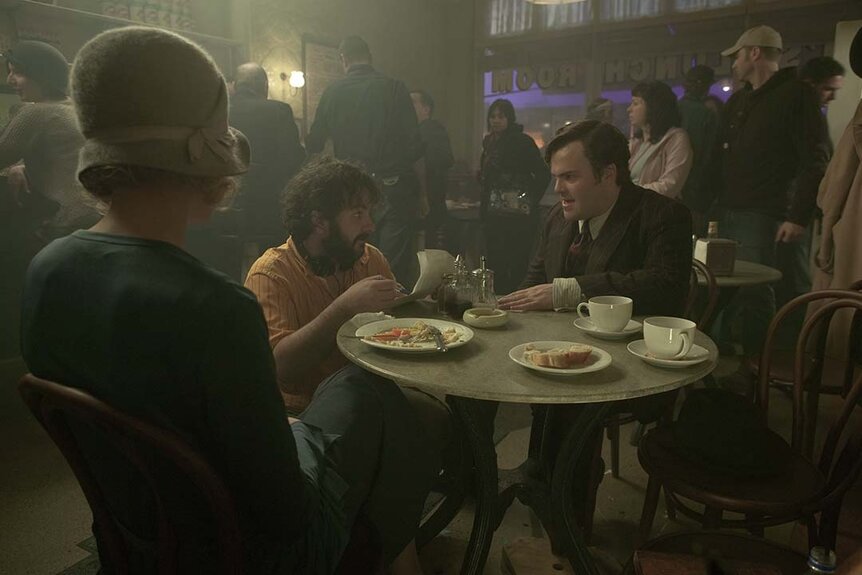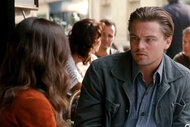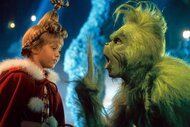Create a free profile to get unlimited access to exclusive videos, sweepstakes, and more!
King Kong Production Designer and Composer Look Back on Peter Jackson's Masterful Remake
"There was never a greater musical opportunity," James Newton Howard tells SYFY WIRE.

James Newton Howard was out to dinner in late October of 2005 when he got a very unusual call from his agent. "He asked me if I wanted to do a movie. I said, ‘Okay, what is it?’ He said, ‘Well, it's gonna be three hours long and you have four weeks.’ And I said, ‘Well, what is it?’ If it was the most amazing thing in the world, I might do it," recalled the prolific composer behind films like Space Jam, Liar Liar, and The Hunger Games during a November 2022 phone call with SYFY WIRE.
That project turned out to be Peter Jackson's ambitious $200 million remake of King Kong for Universal (now streaming on Peacock), which needed a last-minute soundtrack overhaul once it suddenly became clear the existing music (composed by Jackson's Lord of the Rings collaborator, Howard Shore) didn't quite fit. Despite the intense time crunch, Howard couldn't pass up the chance. "If a film composer doesn't want to do King Kong, then he or she should quit," Howard declared. "That movie was what it's all about. There was never a greater musical opportunity."
With just seven weeks to go before the movie opened, the composer had a little over a month to get the job done. He locked himself away in his Santa Monica studio, putting together demos by day and overnighting them to Jackson, who based the entire production in his home country of New Zealand.
Why King Kong was the hardest project of James Newton Howard's composing career
"He would comment back and we finally met each other for the first time at the premiere. But we had a very good rapport. With Fran [Walsh, Jackson's wife, co-screenwriter, and producing partner] as well, by the way," Howard added. "They were very clear. We only got stuck on one part of the movie, which required a number of rewrites, but most of them, he loved right from the get-go and there were very few rewrites, thankfully. Otherwise, I never could have gotten the job done."
When we asked if this was the hardest undertaking of his nearly 40-year-old career, the good-natured Howard didn't miss a beat. "Oh my God, yes," he said. "There'll be never anything to match it because I would never do it again. It aged me, you can't get those years back. Even though Peter’s a joy to work with, it was just such a giant task."
Like a remote island forgotten by time and inhabited by man-eating bugs, creating such a film score in a manner of weeks should be impossible — and yet his feverishly-written motifs perfectly encapsulate the thrilling peril, swooning romance, swashbuckling adventure, jaw-dropping wonder, and gut-wrenching heartache of the big screen epic. "Everything was easy in that movie for me to write because I just felt the storytelling was so clear," summarized the composer. His goal was to deliver "a badass orchestral score with a lot of new themes," and he more than succeeded on that front.
While this type of composer swap is a highly irregular occurrence, particularly for a movie of this size, Jackson's decision to retool one of the greatest American monster movies ever made was anything but an eleventh-hour arrangement.
The origin of Peter Jackson's King Kong
"I remember him having ambitions to do King Kong before Lord of the Rings came around," recalled Grant Major, who had worked as a production designer on all of Jackson's movies since 1994's Heavenly Creatures. "He did mention that it was one of the things he always wanted to look at as a filmmaker because it totally marries with his way of making films, or did at the time — all the animation and miniature photography … all these techniques were fascinating to him."
A fan of the 1933 original since childhood, Jackson nearly traveled to Skull Island in the late '90s, going so far as to pen a number of screenplay drafts alongside Walsh before the studio placed the whole endeavor on ice. Jackson went off to explore Middle-earth instead, garnering enough box office returns and Oscar victories to convince Universal to reconsider its stance on Kong in 2003.
Jackson, Walsh, and co-writer Philippa Boyens went for a back-to-basics approach, once again focusing the narrative around greedy filmmaker Carl Denham (Jack Black) and damsel-turned-ape-charmer Ann Darrow (Naomie Watts). "We were on a roll, you could say," Major added. "I think it was a really nice follow-through after Lord of the Rings to do something on the scale of King Kong."
Not only was the Lord of the Rings trilogy favorable from an experiential and career standpoint (the success and sprawling nature of the Tolkien-inspired films afforded Jackson a generous budget and more creative control), but it also allowed for the technology to catch up to Jackson's lofty plans for the skyscraper-scaling gorilla (ultimately played by motion-capture trailblazer Andy Serkis). Willis H. O'Brien's pioneering stop-motion of the '30s wouldn't cut the mustard in a post-Jurassic Park landscape.
"It’s not a coincidence that he chooses to do things like Lord of the Rings and King Kong," Major said. "They very much suit his way of doing films ... He’s not afraid of creating these big miniature sets and doing miniature photography. [He's] not afraid of big, virtual, conceptual things — starting with Gollum and then moving on to King Kong. It was a logical extension [of that]. Sort of competing with Spielberg and doing dinosaurs and things like that. ‘We can do them just as good or we can do them better!’"
How Peter Jackson's King Kong recreated Depression-era Manhattan in New Zealand
Wanting to remain close to home, Jackson brought the entire shoot to New Zealand, which meant the department leads needed to craft a believable replica of Depression-era Manhattan. "They've got these straight avenues and streets that you can look down for such a long way," Major explained. "There's no way we would be able to find anything like that in the country — we would have to start from scratch. So immediately, it became obvious that we'd have to be building backlot sets for that."
Major and his team pored over endless photographs from the impoverished time period in the hopes of being "as accurate as we possibly could with all the shops that [were in] Times Square and these places that we made were replicas of what was actually there. We also scrutinized the photographs to count the number of people in [them], so that Peter could estimate the number of people he was going to populate the sets with."
Of course, they couldn't go full Philip Seymour Hoffman in Synecdoche, New York and construct a full replica of post-World War I Manhattan. Instead, they built streets and buildings up to certain distances and heights, capping each with a swath of green screen that allowed Weta (Jackson's VFX company) to virtually extend them in post-production. "Weta Digital did an incredible job of segueing from the physical, practical set to the digital extensions," Major continued. "It didn't seem to feel like there was a visible transition at all."
Once Carl Denham evades his irate studio financiers and dupes Ann into taking the lead role in his motion picture, we set sail on a grungy old tramp steamer dubbed Venture. For the ship-based sequences, which occupy an estimated 30 minutes of the runtime, the production "built the boat like three or four times in different guises," Major revealed.
There was a refurbished and seaworthy icebreaker from the '30s; a tiltable, full-size replica of "about two-thirds of the boat" for the studio backlot; a practical miniature from Weta Workshop; and a digital version from Weta Digital. "It’s the handmade nature of Peter’s films that I think really suited these projects," Major said. "His production company’s called WingNut Films, which suggests a kind of DIY, can-do, dexterous function. I think that actually sums up his oeuvre in a way, particularly for that era."
The land that time forgot
And then there's Skull Island itself, the untamed domain of Kong, which contains a nightmarish menagerie of giant lizards and insects eager to munch on the rare treat of human flesh. Our heroes trade one jungle for another, learning the hard way that the movie industry and the Great Depression mean very little to the uncaring inhabitants of the isolated landmass.
"The aesthetic was sort of mad and dangerous," Major said. "Skull Island needed to look like a really difficult place to be in, jagged rocks and things like that. Things that bite you and also the giantism of the ecosystem there was a vivid world to make real. A lot of time was spent trying to rationalize what Skull Island was doing there. Obviously, it's an island that hadn't been discovered before by the Western world and it looked like it's sinking into the sea. It's like the top of something that's falling away into the ocean. And [as a result], the giant creatures — the dinosaurs and the bugs and all that sort of stuff — had to go closer and closer to a smaller space. Everything becomes intensely jam-packed with these dinosaurs and bugs and trees crowding in on this intense environment."
One of the few real-world locations Jackson utilized was the Auckland Civic Theatre, which served as the starting point for Kong's New York rampage in the final act of the movie. The lumbering gorilla smashes his way through the Big Apple, desperately searching for the beauty who would always be his undoing. Interestingly, this was about the only section of the movie's score that Howard encountered trouble with. "He sees Ann and he just stops. Everything gets quiet, he picks her up, and they have that beautiful platonic love moment and they go to Central Park. I kept rewriting that [because] it just wasn't quite there for Peter. That was really costing me time, I did not have time to waste away."
The legacy of Peter Jackson's King Kong remake
King Kong immediately climbed to the top of the domestic box office with just over $66 million upon its wide theatrical release on Dec. 14, 2005. Despite a hefty budget of $207 million (one of the priciest studio investments at the time) and a runtime the size of Kong himself, the remake defied the odds, becoming a financial wonder of the world with over $550 million in worldwide ticket sales. Carl Denham was right: "There's still some mystery left in this world, and we can all have a piece of it…for the price of an admission ticket."
Critics and audiences alike hailed the film as an early Christmas gift of pure cinematic delight that paid loving homage to the 1933 original, while still carving out its own place in blockbuster history as a watershed moment in the world of visual effects, particularly the motion-capture technology used to transform Serkis into a convincingly emotive ape.
The film also became a major awards season contender, going on to nab three Oscar victories for Best Sound Editing, Best Sound Mixing, and, not surprisingly, Best Visual Effects. Well-deserved triumphs, of course, but the amount of love and tender care put into the project should have secured it major nods beyond the technical categories usually won by CGI-heavy titles.
"I don't usually give a s*** about the Academy. I really don’t, but I thought for sure [the score was] gonna get nominated and it didn’t get nominated," Howard admitted. "I think because they didn't believe that I’d really written it in that amount of time, but I did."
Even so, Peter Jackson's King Kong doesn't need a collection of hoity-toity golden statues to secure a place in Hollywood history. The grand scope of its storytelling, sheer ambition of the special effects, and piercing emotional foundation work together in harmony to create movie magic personified. The film stands as a shrine to our love affair with the silver screen.
"We had a wild time," Major concluded. "We brought together a lot of skills that don't often come together for making films ... It was a really, really great period of filmmaking. I love the early 2000s as a moment in time from for making films and we were there — doing it."
King Kong is now streaming on Peacock.
Originally published May 2, 2023.





























